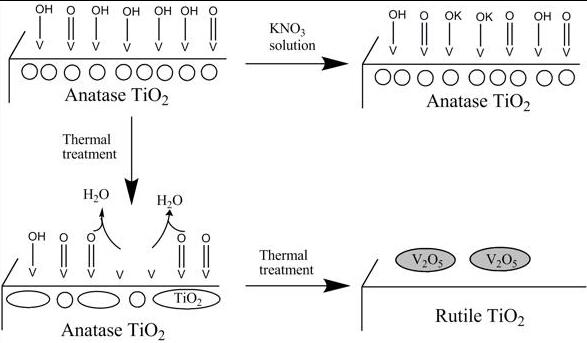Selective catalytic reduction with NH3 (NH3-SCR) is an efficient method for abating NOx from stationary sources and is widely used in coal‐fired power plants currently. V2O5‐WO3/TiO2 catalyst is one of core technologies of NH3-SCR method, which directly influenced NOx removal efficiency in NH3-SCR system. In process of long time use, catalyst gradually shows up deactivation, causing the flue gas can not meet emission standards. The regeneration of deactivated SCR catalyst can efficiently restore the activity of catalysts, so as to lower operating cost and save metal resource. So it is of important economic and environmental significance.
Atmospheric environmental research team, IUE, CAS, taking SCR catalysts of coal-fired power plant for the object, systematacially studied deactivation and regeneration mechanism of SCR catalysts under the condition of using typical burning coal in power plants of our country. The research team through years of study found that: in the operating process of denitrification system, impurity elements in the flue gas would cover the catalyst surface and poison catalyst active sites in different ways, causing deactivation of the SCR catalyst. The research team also mastered the mechanism of regenerating the deactivated catalyst, optimized regeneration formula, effeciently restored the acticity of the deactivated catalyst, reached the aim of recycling and integrated the device that can be used for regeneration of industrialization.
The research was accomplished by doctoral student, Yanke Yu. The corresponding. author is Jinsheng Chen. The related achievements have been published in turns in several journals of the field home and abroad, such as catalysis Communications、Industrial & Engineering Chemistry Research and Chinese Journal of Catalysis and Chinese Science Bulletin. At the same time, nine of the national patent were authorized.
This work was supported by the Bureau of Science and Technology, Fujian Province, Chin, the Strategic Priority Research Program of the Chinese Academy of Sciences, and the National Natural Science Foundation of China.
The article links: http://www.sciencedirect.com/science/article/pii/S1566736713001775
http://pubs.acs.org/doi/abs/10.1021/ie502065b
http://www.chxb.cn/EN/10.1016/S1872-2067(15)60993-7
http://www.cqvip.com/QK/94252X/201426/662538478.html
